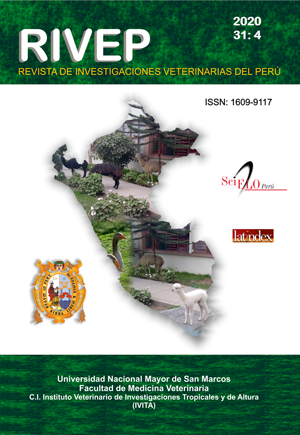Influence of size, variety and sex ratio on tilapia (Oreochromis spp) egg production in an outdoor intensive tropical system
DOI:
https://doi.org/10.15381/rivep.v31i4.19037Keywords:
tilapia, egg production, spawning frequency, variety, sex ratioAbstract
The effect of the variety, size of the females and sex ratio in the production of eggs of Chitralada (CH: Oreochromis niloticus) and Taiwanese red (TR: O. mossambicus x O. niloticus) in outdoor concrete tanks were evaluated in a fish production unit located in the Andean foothills of the state of Trujillo, Venezuela. A 2x2x3 factorial arrangement design was used: two varieties (CH and TR), two sizes (large and small) and three female male proportions (1:1, 2:1 and 3:1). CH females produced greater volume and mass of eggs, spawned 2.4-fold more and were more fertile than TR (p<0.01). Large tilapia had 1.6-fold fewer spawning (p<0.05) and produced fewer eggs per 100 females than small ones (p<0.01). In general, the F:M ratio did not affect the reproductive variables. The small females of both varieties had a higher number of spawning than the large ones, and the large CH tilapia spawned 3.9 times more than the TR of the same size (p<0.01), while in the small ones this difference was only 1.7 times (p<0.05). The large CH tilapias were reproductively more efficient than the females of the same category of the TR variety. In conclusion, the CH tilapia and the smaller size and weight females were reproductively more efficient than those of the TR variety and the larger ones. Regardless of the variety, the reproductive activity was not affected by the proportions between females and males.
Downloads
Downloads
Published
Issue
Section
License
Copyright (c) 2020 Daniel A. Perdomo C., Zenaida A. Corredor Z., Yohan M. Reyna C., Mario González E., Pedro A. Moratinos L., Fernando P. Perea G.

This work is licensed under a Creative Commons Attribution-NonCommercial-ShareAlike 4.0 International License.
AUTHORS RETAIN THEIR RIGHTS:
a. Authors retain their trade mark rights and patent, and also on any process or procedure described in the article.
b. Authors retain their right to share, copy, distribute, perform and publicly communicate their article (eg, to place their article in an institutional repository or publish it in a book), with an acknowledgment of its initial publication in the Revista de Investigaciones Veterinarias del Perú (RIVEP).
c. Authors retain theirs right to make a subsequent publication of their work, to use the article or any part thereof (eg a compilation of his papers, lecture notes, thesis, or a book), always indicating the source of publication (the originator of the work, journal, volume, number and date).



